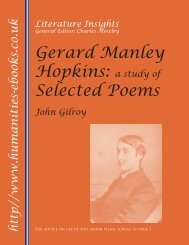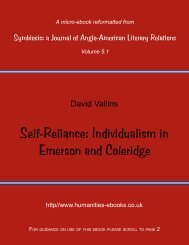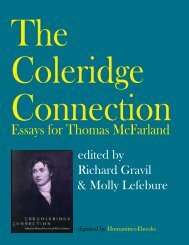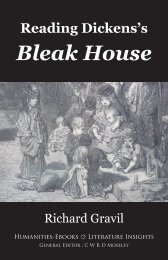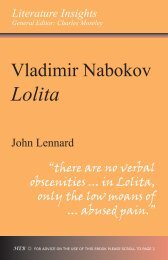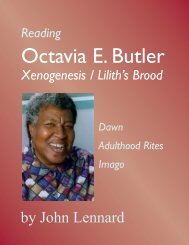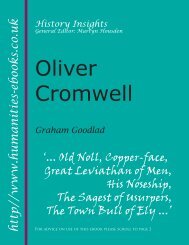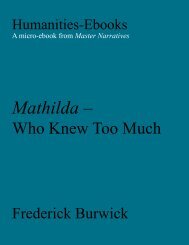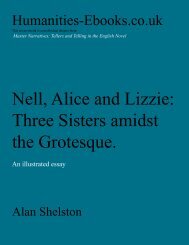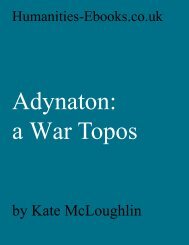William Shakespeare: Hamlet - Humanities-Ebooks
William Shakespeare: Hamlet - Humanities-Ebooks
William Shakespeare: Hamlet - Humanities-Ebooks
Create successful ePaper yourself
Turn your PDF publications into a flip-book with our unique Google optimized e-Paper software.
http//www.humanities-ebooks.co.uk<br />
Literature Insights<br />
General Editor: Charles Moseley<br />
<strong>William</strong> <strong>Shakespeare</strong><br />
<strong>Hamlet</strong><br />
John Lennard<br />
T‘‘‘‘‘‘The final<br />
testimony<br />
to <strong>Shakespeare</strong>’s<br />
generosity is how<br />
much he leaves up<br />
to the actors’<br />
For advice on use of this ebook please scroll to page 2
Publication Data<br />
© John Lennard, 2007<br />
The Author has asserted his right to be identified as the author of this Work<br />
in accordance with the Copyright, Designs and Patents Act 1988.<br />
Published by <strong>Humanities</strong>-<strong>Ebooks</strong>.co.uk<br />
Tirril Hall, Tirril, Penrith CA10 2JE<br />
Reading Options<br />
* To use the navigation tools, the search facility, and other features of the<br />
Adobe toolbar, this Ebook should be read in default view.<br />
* To navigate through the contents use the hyperlinked ‘Bookmarks’ at<br />
the left of the screen.<br />
* To search, expand the search column at the right of the screen or click<br />
on the binocular symbol in the toolbar.<br />
* For ease of reading, use to enlarge the page to full screen<br />
* Use to return to the full menu.<br />
* Hyperlinks appear in Blue Underlined Text.<br />
Licence and permissions<br />
This book is licensed for a particular computer or computers. The original<br />
purchaser may license the same work for a second computer by applying to<br />
support@humanities-ebooks.co.uk with proof of purchase.<br />
Permissions: it is permissible to print sections of the book for your own use,<br />
but not to copy and paste text.<br />
ISBN 978-1-84760-028-8
Contents<br />
A Note on the Author<br />
Preface<br />
A note on the texts of <strong>Hamlet</strong><br />
Acts and scenes in the Arden 3 Q2 <strong>Hamlet</strong><br />
Part 1. Approaching <strong>Shakespeare</strong><br />
1.1 A Man of the Jacobethan Theatre<br />
1.2 Companies—Actors—Stages—Audiences<br />
1.3 Venus and Lucrece<br />
1.4 Errors and Two Gentlemen<br />
Part 2. Approaching <strong>Hamlet</strong><br />
2.1 Revenge with Complications<br />
2.2 A Play by <strong>Shakespeare</strong><br />
Part 3. Actors and Players<br />
3.1 Old <strong>Hamlet</strong> / the Ghost<br />
3.2 Horatio<br />
3.3 Claudius<br />
3.4 Gertrude<br />
3.5 Polonius<br />
3.6 Laertes<br />
3.7 Ophelia<br />
3.8 Rosencrantz & Guildenstern<br />
3.9 The gravediggers<br />
3.10 Osric<br />
3.11 Fortinbras<br />
3.12 <strong>Hamlet</strong><br />
3.13 “The best players in the world”
Part 4. Acts and Devices<br />
4.1 Acts<br />
4.2 Scenes<br />
4.3 Soliloquy and Colloquy<br />
4.4 Verse, Prose, and Song<br />
4.5 Metatheatre<br />
4.6 Doubling<br />
4.7 Special Effects<br />
4.8 Exits<br />
Part 5. <strong>Hamlet</strong> and Twelfth Night<br />
Part 6. Critics’ Corner<br />
6.1 Bibliography<br />
6.2 Web-sites<br />
Hyperlinked Materials<br />
serious doubt<br />
theatre-space<br />
breath-length<br />
discovery-space<br />
comedic and tragedic modes<br />
Vice<br />
Inconclusive<br />
Speculation<br />
Blackfriars<br />
Ciceronian periods
Preface<br />
Like much in the modern world, <strong>Hamlet</strong> has acquired a tendency to become obese. In<br />
the Arden 2 <strong>Shakespeare</strong>, Harold Jenkins’s edition was twice the width of every other<br />
play; in Arden 3, Ann Thompson’s and Neil Taylor’s edition is in two volumes, jointly<br />
twice as wide as Jenkins’s one, and such remorseless bulking is an unhappy trend.<br />
The play can also expand in performance: a fine 2001 Royal <strong>Shakespeare</strong> Company<br />
(RSC) stage-production (directed by Steven Pimlott and starring Sam West) ran over<br />
four hours with two intervals, and Kenneth Branagh’s 1996 film-adaptation, lasting<br />
a whopping 242 minutes, is rarely watched from start to finish, especially in one go.<br />
Still more off-puttingly for students, <strong>Hamlet</strong> criticism has the same expansiveness.<br />
This Literature Insight is determinedly short. Great need not mean ponderous,<br />
and on stage <strong>Hamlet</strong> (like most <strong>Shakespeare</strong>) almost always does better at a brisk<br />
canter than a solemn march. In dealing with something as complex as the world’s<br />
premier Early Modern tragedy simplicity is not always useful; straightforwardness<br />
and cogency almost always are, so scholarly problems are ruthlessly relegated to<br />
references, while links in the bibliography make available to interested readers the<br />
primary materials, that they may see for themselves what the evidence supports.<br />
Casting matters are trickier, for there is almost no evidence about the first casting of<br />
any of <strong>Shakespeare</strong>’s plays, and most of what is said is pure speculation. But someone<br />
first played each role, and a pool of most probable names is known: so the game<br />
can be compulsive. It is in no way necessary, but a grasp of the practical necessities<br />
and constraints <strong>Shakespeare</strong> faced in writing (which for a working playwright of his<br />
kind means casting) is very helpful, and inevitably brings more speculative territory<br />
into view. So sometimes I speculate, but only in footnotes or link-text, and in Part 6,<br />
where it is properly flagged and discussion can be as careful as it need.<br />
Plot-summaries etc. are widely available, so I assume readers have read <strong>Hamlet</strong><br />
at least once and know what happens. The only special thing readers—particularly<br />
those without theatrical experience—are asked to do is to think seriously about the<br />
<br />
<br />
There have been three series of Arden editions: the second appeared 1946–82, the third began to<br />
appear in 1993.<br />
‘Early Modern’: for historians, the period 1500–1700; ‘Modern’ = 1700–present.



